
The Sonoran Desert is a hot desert in North America and ecoregion that covers the northwestern Mexican states of Sonora, Baja California, and Baja California Sur, as well as part of the southwestern United States. It is the hottest desert in both Mexico and the United States. It has an area of 260,000 square kilometers (100,000 sq mi).
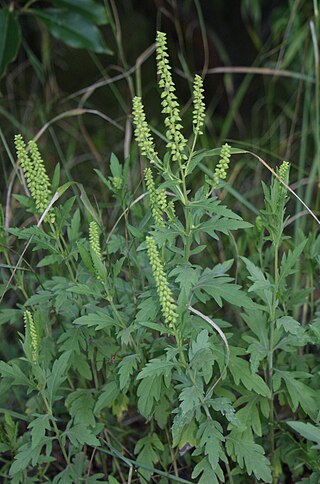
Ragweeds are flowering plants in the genus Ambrosia in the aster family, Asteraceae. They are distributed in the tropical and subtropical regions of the Americas, especially North America, where the origin and center of diversity of the genus are in the southwestern United States and northwestern Mexico. Several species have been introduced to the Old World and some have naturalized and have become invasive species. In Europe, this spread is expected to continue, due to ongoing climate change.

Palafoxia, or palafox, is a genus of North American flowering plants in the Bahia tribe within the Asteraceae.
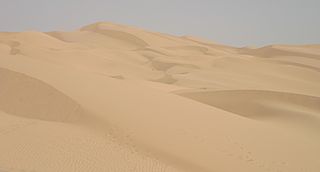
The Yuma Desert is a lower-elevation section of the Sonoran Desert in the southwestern United States and the northwest of Mexico. It lies in the Salton basin. The desert contains areas of sparse vegetation and has notable areas of sand dunes. With an average rainfall less than 8 inches (200 mm) each year, it is among the harshest deserts in North America. Human presence is sparse throughout, the largest city being Yuma, Arizona, on the Colorado River and the border of California.

Ambrosia dumosa, the burro-weed or white bursage, a North American species of plants in the family Asteraceae. It is a common constituent of the creosote-bush scrub community throughout the Mojave desert of California, Nevada, and Utah and the Sonoran Desert of Arizona and northwestern Mexico.
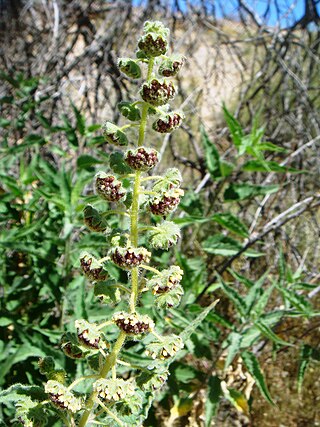
Ambrosia ambrosioides, also known as canyon ragweed or chicura, is a ragweed found in the deserts of northern Mexico, Arizona, and California.

The Lower Colorado River Valley (LCRV) is the river region of the lower Colorado River of the southwestern United States in North America that rises in the Rocky Mountains and has its outlet at the Colorado River Delta in the northern Gulf of California in northwestern Mexico, between the states of Baja California and Sonora. This north–south stretch of the Colorado River forms the border between the U.S. states of California/Arizona and Nevada/Arizona, and between the Mexican states of Baja California/Sonora.

Ambrosia psilostachya is a species of ragweed known by the common names Cuman ragweed and perennial ragweed, and western ragweed.
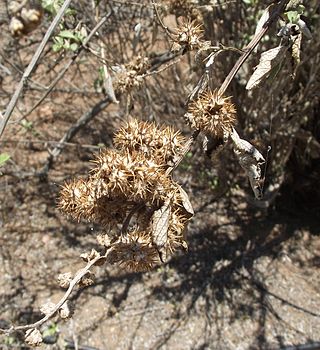
Ambrosia chenopodiifolia is a species of ragweed known by the common names San Diego bursage and San Diego bur ragweed. It is native to the Mexican states of Baja California and Baja California Sur, as well as to Orange and San Diego Counties it int US State of California. It is a member of the coastal sage scrub plant community.

Ambrosia eriocentra is a North American species of ragweed known by the common names woolly bursage and woollyfruit burr ragweed.
Ambrosia ilicifolia is a species of ragweed known by the common names hollyleaf burr ragweed and hollyleaf bursage.

Ambrosia pumila is a rare species of herbaceous perennial plant known by the common names San Diego ragweed and San Diego ambrosia. It is native to far southern California, Baja California, and Baja California Sur. It grows in floodplains and open grasslands in proximity to wetland areas.

Abutilon parishii is a species of flowering plant in the mallow family known by the common names Parish's Indian mallow and Pima Indian mallow. It is native to Arizona in the United States and Sonora in Mexico.

Baccharis salicina is a species of plant in the family Asteraceae. Common names include willow baccharis, and Great Plains false willow. It is a shrub found in North America where it grows in mildly saline areas.

Ambrosia salsola, commonly called cheesebush, winged ragweed, burrobush, white burrobrush, and desert pearl, is a species of perennial shrub in the family Asteraceae native to deserts of the southwestern United States and northwestern Mexico.
Flora of the Sonoran Desert includes six subdivisions based on vegetation types. Two are north of the boundary between the United States and Mexico, and four are south of the boundary. The flora of the Colorado Desert are influenced by the environment of the very dry and hot lower areas of the Colorado River valley, which may be barren, treeless, and generally have no large cacti. Flora of the Arizona Upland are comparatively lush, with trees and large columnar cacti that can withstand winter frosts. Those subdivisions of the Sonoran Desert which lie south of the international border are characterized by plants that cannot withstand frost.
Ambrosia cordifolia, called the Tucson bur ragweed, is a North American species of plant in the family Asteraceae. It is native to northern Mexico and the State of Arizona in the United States.

Ambrosia monogyra is a species of flowering plant in the sunflower family commonly known as the singlewhorl burrobrush, leafy burrobush, slender burrobush, and desert fragrance. Ambrosia monogyra is native to North America and is typically found in canyons, desert washes, and ravines throughout arid parts of the southwestern United States and northern Mexico. This species has green, threadlike leaves that emit a distinctive odor when crushed, and flowers from August to November. The fruits have distinctive wings in their middle that aid in dispersion through wind and water.
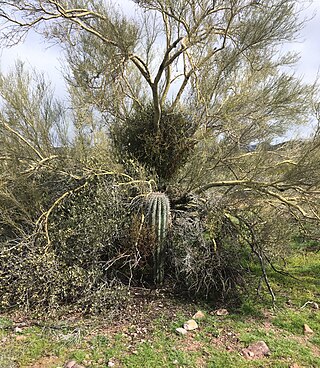
Nurse plants are plants that serve the ecological role of helping seedlings establish themselves and protecting young plants from harsh conditions. This effect is particularly well studied among plant communities in xeric environments.















